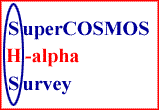
|
|
|
|
|
|
|
|
|
|
|
|
|
|
|
|
|
|
|
|
| |
 | |
| IFA ROE |
Introduction to extracting images from the SHS
The pixel extraction form Get an Image offers the user a variety of options for extracting pixel images from the SHS. There is more functionality built-in to this interface than for the standard SSS due to the unique characteristics and requirements of the H-alpha survey.Firstly co-ordinates of a chosen region to extract are entered in free format in either equatorial co-ordinates: Right Ascension (RA) & Declination (Dec), e.g. 07 54 55.0 -34 44 13, with equinox (B1950 or J2000), or galactic l,b co-ordinates in decimal degrees, e.g. 250.5709 -3.4301. The size of the region to extract is then entered in arcmin (with a choice of independent X-Y dimension) up to a maximum area of 900 sq.arcmin. The selected Galactic Plane waveband(s) required is then input (H-alpha and/or SR) followed by the option to return the pixel data in the standard SuperCOSMOS density units or in Intensity (default) or Transmission space. There is also an option in the pixel units selection which applies a flat-field to the H-alpha pixel data but only in Intensity space.
Once these choices are made the web-form returns a gzipped FITS format image(s) of the relevant SuperCOSMOS scan(s). If you do not have software that can view FITS images then you should also choose to generate the GIF image.
Note the GIF image is intended for visualisation purposes only and is not intended for serious scientific use.
Users unfamiliar with RA/Dec or Galactic l,b co-ordinates might like to look at the examples page, which lists coordinates of some interesting H-alpha emitting objects and describes the format for entering RA/Dec and l,b.
The FITS image has 0.67 arcsec (10micron) pixels and a built-in World Coordinate System (WCS). Also Included in the FITS file are two FITS tables cataloging the objects found in the requested area (as determined by the SuperCOSMOS Image Analysis Mode (IAM)).
Also returned is a tab-separated object listing that can be read together with the FITS image into the GAIA software.
A third FITS extension returns a quality map for the pixels in the chosen image region intended to identify ocassions when part of the extracted image contains non-optimal data. Further details on this are found here.
For the form to successfully return data the required survey region must have been measured and put on-line. Some survey films have not yet be taken and/or scanned. A summary of scans available on-line is given under Sky coverage.
The user is referred to the section on spurious images which describes what to look out for in the extracted pixel data due the more elevated levels of crud ocassionally present in the SuperCOSMOS SHS film scans (due to the film material being prone to static charge attracting dust).
Finally, a more detailed guide to using to the image extraction form and accessing the data with GAIA is given here.
Home | Intro | Get an Image | Get a Catalogue
Coverage | Documentation | History | Links
WFAU, Institute for Astronomy,
Royal Observatory, Blackford Hill
Edinburgh, EH9 3HJ, UK
M.Read@roe.ac.uk
30/7/2008